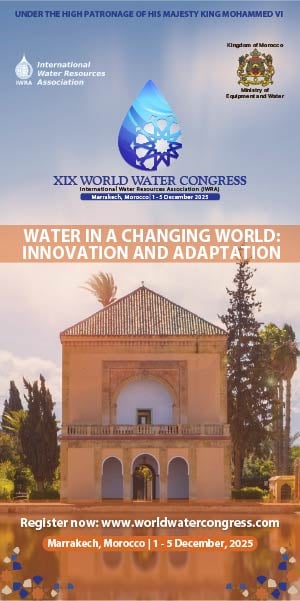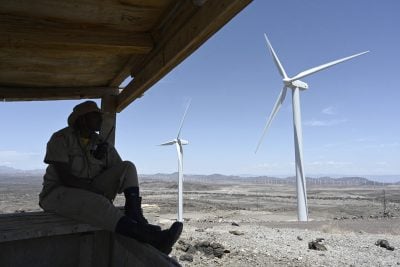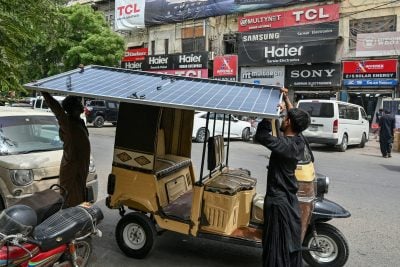The Namibian government has announced that it will choose the German consortium Hyphen Hydrogen Energy as the preferred bidder for its green hydrogen project in the Tsau Khaeb National Park.
The large-scale green hydrogen project is the most notable project in the government’s Southern Corridor Development Initiative (SCDI) in Kharas, the country’s southernmost region.
James Mnyupe, economic advisor to the president and hydrogen commissioner, noted that the region is particularly suitable due to its large solar and wind resources and proximity to the coast. Hyphen has described the park as one of the top five locations in the world for the production of low-cost hydrogen.
The agreement grants the company the right to operate the project for 40 years with operations set to begin in 2026 and plans to produce up to 300,000 tonnes of green hydrogen per year. With an eventual project size of $9.4bn, the country wants to establish itself as a major power in the production of green hydrogen.
Although the green hydrogen sector currently represents less than 1% of global hydrogen production, African countries including Egypt, Morocco and South Africa are all attracted to its potential in a world shifting towards renewable energies.
The World Platinum Investment Council estimates that the sector will be worth $2.5 trillion by 2050, supporting 30m jobs. Japan alone is planning to import up to 800,000 tonnes of the product annually from 2030.
At present, global hydrogen production is based on stripping hydrogen from fossil fuels such as methane, natural gas or coal. In contrast, green hydrogen energy is produced using electrolysis, a process that separates hydrogen molecules from desalinated water using wind turbines or solar energy.
This process converts electrical energy into chemical energy without carbon emissions. The hydrogen recovered makes it possible to obtain energy in two ways: through its direct combustion with oxygen or in the form of electricity via a fuel cell.
Green hydrogen may be used to decarbonise sectors which are hard to electrify, such as steel and cement production and has widespread possible applications in the transport sector, thus helping to limit climate change.
But with the technology requiring extensive new investments in infrastructure, Namibia and its partners have their work cut out to make the project a success.
The potential of green hydrogen
Green hydrogen has been increasingly earmarked for growth. The reduction of greenhouse gas emissions was at the centre of debates at November’s global climate change conference in Glasgow, where the Cop26 Energy Transition Council set the objective of doubling investments in green energies by 2030.
Meanwhile, vulnerable to the effects of climate change and highly dependent on the agricultural sector, Namibia has recently experienced extreme drought. To address climate change, Namibia has pledged to reduce its emissions by 91% over the next five years and reach net zero by 2050.
Namibia is the first country in Africa to include environmental protection in its constitution and green energy is a major pillar of its economic recovery plan launched in March 2021, Harambee Prosperity Plan II.
Namibia plans to exploit its renewable energy potential to reduce the region’s reliance on carbon-based fuels. By fighting against climate change and taking advantage of its natural resources, Namibia says it hopes to attract significant foreign direct investment to the green energy sector.
One German government expert expects a kilogram of hydrogen from the country to cost approximately $2, a competitive price that would place Namibia among high-potential green hydrogen producers and position it as a major domestic producer and exporter. Namibia has abundant reserves of platinum and iridium, two metals used to separate hydrogen from water.
In addition, there are vast tracts of unused land in Namibia, and the country enjoys over 3,500 hours of sunshine and ideal wind speeds. These factors allow it to exploit solar and wind energy to meet its needs.
Challenges for Namibia
Despite the Namibian government’s optimism, the country faces several challenges as it seeks to become a major producer of green hydrogen. The amount of water needed to produce hydrogen is a challenge in a largely desertified country marked by water scarcity in which desalination can be very expensive.
The cost of the electrolysis used in the hydrogen manufacturing process is also high. Namibia is counting on the low cost of its green hydrogen to become one of the world’s leading exporters, but the competitiveness of Namibian green hydrogen is not guaranteed.
Without a net advantage in terms of price, Namibia could find it hard to compete with more experienced producers such as Australia, Chile and Morocco, the last of which has strong links to the European market.
Concerns have also been expressed about the cost and feasibility of developing hydrogen infrastructure in Namibia. The size of the investment almost equals the entire GDP of Namibia in 2020 ($10.7bn), and Namibia will need to source extensive capital from DFIs and the private sector if the $9.4bn budget is to be realised. The initial phase of the project will be a more modest $4.4bn prior to a planned expansion in the late 2020s.
Policies and regulations are essential for the government to attract investment in sustainable energy and provide investors with a stable environment. While Namibia has committed to producing a legal framework for green hydrogen exploitation, no such framework currently exists.
Benefits for the country
Still, if the project does get off the ground, it could position the country as a distributor for Southern Africa and Europe, and would make it possible to collect concession rights, a contribution to the sovereign fund and taxes. At least 18,000 direct jobs could be created, including 3,000 permanent roles, and the surrounding communities will benefit from the surplus water desalinated by the plant.
The initiative aims not only to bring Namibia into the global energy market but also to decarbonise all sectors of the country and strengthen the Namibian job market.
With the country’s economy ravaged by the Covid-19 pandemic, the Prosperity Plan aims to kick-start Namibia’s economic recovery and growth, creating meaningful jobs and new industries. Growth of 3.6% is expected this year after 1.3% in 2021, but the economy contracted by -8% as the pandemic hit in 2020.
Hyphen director Tobias Bischof-Niemz said that the consortium involved in the project comprised shareholders and technical partners that were world leaders in their respective fields: “This collective deep technical expertise across the entire green hydrogen value chain, combined with our financial strength and experience in developing, fundraising and implementing infrastructure projects in Africa, will be crucial in successfully delivering a project of this magnitude and complexity.”
“This is a milestone project,” said Nangula Uaandja, head of the Namibian Investment Promotion and Development Board. “This is exactly the kind of project the board aims to attract as it is directly aligned to our mandate of unlocking investment opportunities that drive the economy forward, and most importantly, improve the quality of life for most Namibians.”
Want to continue reading? Subscribe today.
You've read all your free articles for this month! Subscribe now to enjoy full access to our content.
Digital Monthly
£8.00 / month
Receive full unlimited access to our articles, opinions, podcasts and more.
Digital Yearly
£70.00 / year
Our best value offer - save £26 and gain access to all of our digital content for an entire year!

 Sign in with Google
Sign in with Google 





